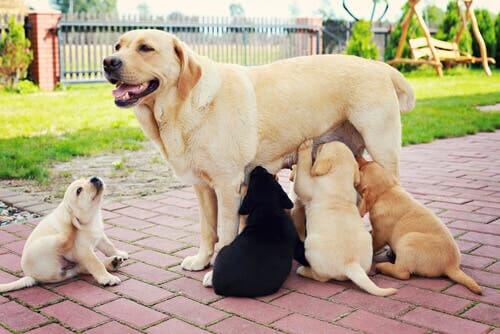Key Facts About Breastfeeding in Dogs


Written and verified by biochemistry Luz Eduviges Thomas-Romero
Breastfeeding in dogs is a phase when puppies get a lot more than milk! Find out what makes breastfeeding so important and what the benefits are for puppies.
Breastfeeding in dogs isn’t a common topic of conversation. Certainly, dogs have been reproducing for a long time without human help. However, it’s still important to have accurate information about caring for your dog.
Next, we’ll give you some tips so you can better care for puppies that are on the way (or already here) in your home. Listen up!
1. Breastfeeding is the first form of vaccine mammals receive
Did you know that the intestine isn’t just important for nutrition? It’s also the largest immune system organ in mammals. In fact, 70% of the body’s immune system is in the gastrointestinal tract.
As a result, the interaction between intestinal tissue and agents provided by breast milk is a key form of protection against infections in newborns.
2. At birth, the intestine isn’t fully matured
Throughout life, the intestinal wall provides mammals with unique protection. The intestinal wall acts as a physical barrier, and prevents the passage of harmful substances and infections.
However, in newborns, this barrier isn’t fully formed. This gives newborns an advantage – the antibodies in breast milk are able to cross this barrier. This is extremely beneficial for the newborn.
In fact, mothers give some white blood cells from their own blood to protect the newborn during its first days of life.
Breast milk also provides antibodies and other microbicidal agents that guarantee a baby’s health.

3. Colostrum is vital to puppies’ health
Breast discharge on the first day after delivery is known as ‘colostrum.’ Colostrum is rich with antibodies that help strengthen puppies’ immature immune systems.
This substance also helps establish a balance of bacteria in the newborn’s gut. Beneficial bacteria work to promote nutrient absorption. They also reduce infection, diarrhea, and intestinal inflammation.
Establishing good intestinal microflora also induces the maturation of intestinal wall cells and allows the barrier to function. Researchers have found that colostrum helps improve immunity and modulate intestinal microflora in puppies.
4. Breastfeeding in dogs is key to getting rid of some diseases
One of the protective functions of the intestine is to get rid of any microbes that cause disease and neutralize toxins. These functions are generally associated with IgA-type antibodies. These antibodies recognize disease-causing microbes and help eliminate them.
Breast milk is enriched with IgA. When IgA binds to disease-causing microbes, it prevents these diseases from sticking to intestinal mucus. As a result, IgA prevents infections caused by bacteria, viruses, and parasites.
5. Breast milk promotes the growth of probiotic bacteria
A diverse group of bacteria that produce lactic acid – known as lactobacilli – have a beneficial effect on an offspring’s health. The benefit of lactobacilli probiotics is established during lactation, but it lasts until adulthood.
Researchers have shown that probiotics decrease the incidence, severity, and duration of diarrhea. In fact, breast milk contains sugars that the intestine actually can’t digest. Instead, the lactobacillus bacteria use these sugars to multiply in the infant’s intestine.

6. The duration of breastfeeding in dogs varies
One key to avoiding mistakes when weaning is observing your dogs. Consider two factors – your dogs’ breed and rate of growth.
Needless to say, all litters are different. For example, a larger litter of eight puppies will need other food introduced before a smaller litter of three puppies. This is true, even if it’s only to give the mother a break.
In general, in smaller dog breeds, weaning occurs around 5 weeks old. A healthy puppy should be playful and energetic with thick, shiny fur by this age. Brown stools are also a sign that your puppy is digesting nutrients well.
One final recommendation is not to rush the separation of the litter from the mother. Even after weaning, mothers can teach the puppies many important lessons. These lessons include bite control, identifying their place in the pack, and how to play well.
All cited sources were thoroughly reviewed by our team to ensure their quality, reliability, currency, and validity. The bibliography of this article was considered reliable and of academic or scientific accuracy.
- Adkins Y, Lepine AJ, Lönnerdal B. (2001) Changes in protein and nutrient composition of milk throughout lactation in dogs. Am J Vet Res. 62(8):1266-72.
- Satyaraj E, Reynolds A, Pelker R, et al. (2013) Supplementation of diets with bovine colostrum influences immune function in dogs. Br J Nutr. 110(12):2216-21.
- Luick Jr, Parker Hr, Andersen Ac. (1960) Composition of beagle dog milk. Am J Physiol. 199:731-2.
This text is provided for informational purposes only and does not replace consultation with a professional. If in doubt, consult your specialist.